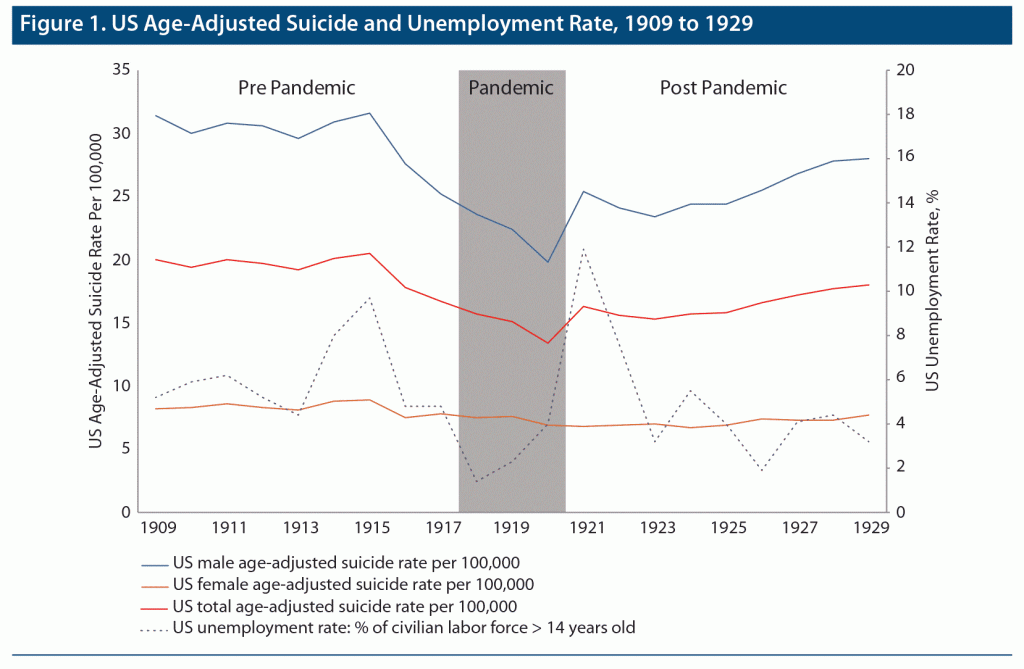Prim Care Companion CNS Disord 2021;23(3):20com02882
To cite: Bastiampillai T, Allison S, Brailey J, et al. Pandemics and social cohesion: 1918–1920 influenza pandemic and the reduction in US suicide rates. Prim Care Companion CNS Disord. 2021;23(3):20com02882.
To share: https://doi.org/10.4088/PCC.20com02882
© Copyright 2021 Physicians Postgraduate Press, Inc.
aDepartment of Psychiatry, Monash University, Melbourne, Victoria, Australia
bCollege of Medicine and Public Health, Flinders University, Adelaide, South Australia, Australia
cDepartment of Psychiatry, Southern Adelaide Local Health Network, Flinders Medical Centre, Adelaide, South Australia, Australia
dDepartment of Psychiatry, Li Ka Shing Faculty of Medicine, The University of Hong Kong, Hong Kong Special Administrative Region, Hong Kong, China
eAcademic Unit of Psychiatry and Addiction Medicine, Australian National University Medical School, Canberra Hospital, Canberra, Australia
*Corresponding author: Tarun Bastiampillai, MBBS, FRANZCP, Department of Psychiatry, Monash University, Wellington Rd, Clayton 3800, Melbourne, Victoria, Australia ([email protected]).
The coronavirus disease 2019 (COVID-19) pandemic may increase US suicide rates due to the combined impact of high COVID-19–related mortality, acute recession, income shock, bankruptcy, decline in asset values, loss of savings, rising unemployment, job stress and insecurity, social isolation, barriers to accessing treatment, increased population distress and anxiety, and increased alcohol misuse.1,2 There is some suggestion that previous epidemics may have increased suicide rates in Hong Kong (severe acute respiratory syndrome epidemic) and in the United States (influenza pandemic: 1918–1920).3,4
However, increased social cohesion through shared experience in disasters (ie, a “pulling-together effect”) may mitigate the negative impact of COVID-19 on suicide rates.2 Durkheim5 hypothesized that greater social integration protects against suicide, and these protective effects may become evident during the community-wide responses to COVID-19. Findings from the last influenza pandemic between 1918 and 1920 suggest that Durkheim’s hypothesis could be correct for pandemics: US suicide rates fell during this influenza pandemic, only increasing during a subsequent economic downturn.
The 1918–1920 influenza pandemic killed 1%–2.7% of the world’s population, reducing US life expectancy by 13%, with 0.51% of the US population dying due to the Spanish flu.6,7 Analysis of the health and economic effects of the 1918–1920 influenza pandemic and impact on US suicide rates may help predict these corresponding effects of COVID-19.
US age-standardized suicide rates (Figure 1) during the pandemic (1918–1920) averaged 14.7 per 100,000, which were 24% lower than suicide rates between 1909 and 1917 (19.3 per 100,000).8,9 Male and female suicide rates declined by 26% and 12%, respectively, during this period.8,9 Following the pandemic (1921–1929), suicide rates increased by 12%, with male suicide rates increasing by 16% and female suicide rates declining slightly by 3%.8,9 Our results differ from those of Wasserman,3 which suggested an increase in US suicide rates during the first influenza wave (1918) followed by a decrease in suicide rates during the second influenza wave (1919–1920). However our data obtained from the US Centers for Disease Control and Prevention (CDC) showed a reduction of US suicide rates throughout each year of the pandemic compared to the baseline period.8,9
Durkheim’s5 hypothesis about the protective effects of social integration was specifically related to times of war when suicide rates decline due to increasing levels of social integration. The combined effects of the 2 major US crises of 1918 related to World War 1 and the Spanish flu outbreak were collective adversities, which may have increased social cohesion and contributed to a reduction in US suicide rates.
However, there is a well-established link between rising unemployment rates and higher suicide rates, especially among males.1 In contrast to COVID-19, the 1918–1920 influenza pandemic was associated with lower unemployment rates and an improved economy. The reduced suicide rate during the pandemic coincided with reduced unemployment levels, which averaged 2.6% compared to the unemployment level of 6% between 1909 and 1917 (see Figure 1) and an increase in gross domestic product per capita (Table 1) by 7% to $8,604 (in 1918–1920 compared with 1917).10,11 Temporally distant and compared with the 1918–1920 pandemic, US suicide rates increased by 11% during the 1921 recession (unemployment rate reached 11.9%).8–10
Our analysis of the health and economic effects of the Spanish flu pandemic and the ensuing 1921 recession indicates that US suicide rates are more likely to be influenced by significant economic recession and higher unemployment due to economic effects of COVID-19 public health measures (eg, social distancing) rather than the direct health and psychological impacts of the COVID-19 pandemic. Thus, a COVID-19–induced economic recession may increase US suicide rates.
In contrast to the United States, in Taiwan, there was a small and short-lived, statistically significant increase in suicide rates during a second wave of infection of the influenza pandemic between 1918 and 1920.12 With the current ongoing COVID-19 pandemic in the United States,13 it is possible that similar later effects may emerge. US suicide rates may increase during further waves of COVID-19, as observed in the Taiwanese influenza (1918–1920) second wave, possibly influenced by increased fearfulness primed by the first wave, as well as social isolation, unemployment, and economic effects.12
Early suicide research during the current COVID-19 pandemic from high-income countries shows either no rise in suicide rates (Massachussets, United States; Victoria and Queensland, Australia; England) or a decline in suicide rates (Japan, Norway).14,15 Whether the negative economic effects of COVID-19, or effects of further waves of infection, will surpass any potential beneficial effects of increased social cohesion during the immediate crisis remains unknown. Accordingly, US public health authorities should undertake contemporaneous population mental health monitoring, including suicide rates, enabling timely evidence-based policy responses appropriately targeted to high-risk populations and regions during the current pandemic.
Received: November 27, 2020.
Published online: April 29, 2021.
Potential conflicts of interest: None.
Funding/support: None.
References (15)

- Bastiampillai T, Allison S, Looi JCL, et al. The COVID-19 pandemic and epidemiologic insights from recession-related suicide mortality. Mol Psychiatry. 2020;25(12):3445–3447. PubMed CrossRef
- Reger MA, Stanley IH, Joiner TE. Suicide mortality and coronavirus disease 2019—a perfect storm? JAMA Psychiatry. 2020;77(11):1093–1094. PubMed CrossRef
- Wasserman IM. The impact of epidemic, war, prohibition and media on suicide: United States, 1910–1920. Suicide Life Threat Behav. 1992;22(2):240–254. PubMed
- Cheung YT, Chau PH, Yip PS. A revisit on older adults suicides and Severe Acute Respiratory Syndrome (SARS) epidemic in Hong Kong. Int J Geriatr Psychiatry. 2008;23(12):1231–1238. PubMed CrossRef
- Durkheim E. Suicide: A Study in Sociology. New York, NY: Free Press; 1897.
- Roser M. The Spanish flu (1918–20): The global impact of the largest influenza pandemic in history. Our World in Data. March 2020. Accessed November 21, 2020. https://ourworldindata.org/spanish-flu-largest-influenza-pandemic-in-history
- Barro RJ, Ursúa JF, Weng J. The coronavirus and the great influenza pandemic: Lessons from the “spanish flu” for the coronavirus’s potential effects on mortality and economic activity. Working Paper 26866. National Bureau of Economic Research. 2020. Accessed November 21, 2020. https://www.nber.org/papers/w26866
- National Center for Health Statistics. HIST 293. Age-Adjusted Death Rates for Select Causes by Race and Sex Using Year 2000 Standard Population: Death Registration States, 1900–32 and United States 1933–49. Centere for Disease Control and Prevention. Accessed November 21, 2020. https://www.cdc.gov/nchs/data/dvs/hist293_1900_49.pdf
- Long-term trends in deaths of despair. United States Congress Committee. September 2019. Accessed November 21, 2020. https://www.jec.senate.gov/public/index.cfm/republicans/2019/9/long-term-trends-in-deaths-of-despair
- Lebergott S. Annual estimates of unemployment in the United States, 1900–1954. National Bureau of Economic Research. 1957. Accessed November 21, 2020. https://www.nber.org/chapters/c2644
- Roser M. Economic Growth. Our World in Data. 2013. Accessed November 21, 2020. https://ourworldindata.org/economic-growth
- Chang Y-H, Chang S-S, Hsu C-Y, et al. Impact of pandemic on suicide: excess suicides in Taiwan during the 1918–1920 influenza pandemic. J Clin Psychiatry. 2020;81(6):20l13454. PubMed CrossRef
- Coronavirus Resource Centre. John Hopkins University. 2020. Accessed November 21, 2020. https://coronavirus.jhu.edu/map.html
- John A, Pirkis J, Gunnell D, et al. Trends in suicide during the COVID-19 pandemic. BMJ. 2020;371:m4352. PubMed CrossRef
- Leske S, Kõlves K, Crompton D, et al. Real-time suicide mortality data from police reports in Queensland, Australia, during the COVID-19 pandemic: an interrupted time-series analysis. Lancet Psychiatry. 2021;8(1):58–63. PubMed CrossRef
Please sign in or purchase this PDF for $40.





